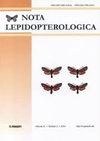A provisional checklist of European butterfly larval foodplants
IF 0.7
4区 农林科学
Q4 ENTOMOLOGY
引用次数: 7
Abstract
Successful conservation of butterflies is dependent on knowing which larval foodplants they use. However, many published lists of larval foodplants have been copied from previous lists, which in turn have been copied from previous lists. Consequently, errors have crept in, and many plant names have long been superseded. This can result in duplicates in the list, with the same plant being given two different names. Most plant lists do not include the authority, which can make it difficult or impossible to identify which plant is being referred to. For the first time, a list of the current accepted plant names utilised by 471 European butterfly larvae is presented, with references. Where possible, errors in previous lists have been removed. The list of larval foodplants doubled from previous published lists. This has resulted in a list of 1506 different plant species in 72 different families. 86 plant records are only known at the generic level. Larval foodplants of 25 butterfly species are currently unknown. Whilst most plant families are utilised by less than six butterfly species, a few plant families are particularly favoured, with the Poaceae and Fabaceae being the most popular. Similarly, most plant species are only utilised by a few butterfly species, but Festuca ovina and Festuca rubra are favoured by a large number of butterfly species. 20% of European butterfly larvae are monophagous, 50% are oligophagous, and 30% are polyphagous, with Celastrina argiolus able to use plants in 19 different families.A欧洲蝴蝶幼虫食用植物临时清单
蝴蝶的成功保护取决于知道它们使用的是哪些幼虫食用植物。然而,许多已发表的幼虫食源性植物列表都是从以前的列表中复制的,而以前的列表又是从以前列表中复制出来的。因此,错误悄然而至,许多植物名称早已被取代。这可能会导致列表中出现重复,同一株植物被赋予两个不同的名称。大多数植物清单都不包括权威机构,这可能会使识别被提及的植物变得困难或不可能。首次提供了471只欧洲蝴蝶幼虫使用的当前可接受的植物名称清单,并附有参考文献。在可能的情况下,已删除以前列表中的错误。幼虫食用植物的名单比以前公布的名单翻了一番。这就形成了一份72个不同科的1506种不同植物的名单。86项植物记录仅在一般水平上为人所知。目前尚不清楚25种蝴蝶的幼虫食用植物。虽然大多数植物科的蝴蝶种类不到六种,但少数植物科尤其受欢迎,其中波科和Fabaceae最受欢迎。同样,大多数植物物种只被少数蝴蝶物种利用,但羊茅和红羊茅受到大量蝴蝶物种的青睐。20%的欧洲蝴蝶幼虫是单食性的,50%是寡食性的,30%是多食性的,粘脊南蝶能够使用19个不同科的植物。
本文章由计算机程序翻译,如有差异,请以英文原文为准。
求助全文
约1分钟内获得全文
求助全文
来源期刊

Nota Lepidopterologica
Agricultural and Biological Sciences-Insect Science
CiteScore
1.70
自引率
14.30%
发文量
20
审稿时长
14 weeks
期刊介绍:
Nota Lepidopterologica is the scientific, peer-reviewed journal of the Societas Europaea Lepidopterologica (SEL). It publishes original contributions to the study of mainly but not exclusively Palaearctic Lepidoptera, especially on taxonomy, morphology/anatomy, phylogenetics, biogeography, ecology, behaviour, and conservation, but also on any other aspects of lepidopterology.
All articles are published in English, with the possibility of having the summary written in other languages. All submitted manuscripts are subject to peer-review by the leading specialists for the respective topic. The journal is published in open access high-resolution PDF, semantically enriched HTML and machine-readable XML versions.
All papers can be freely copied, downloaded, printed and distributed at no charge. Authors and readers are thus encouraged to post the pdf files of published papers on homepages or elsewhere to expedite distribution. Publication is free for the SEL members and there is no charge for color.
 求助内容:
求助内容: 应助结果提醒方式:
应助结果提醒方式:


